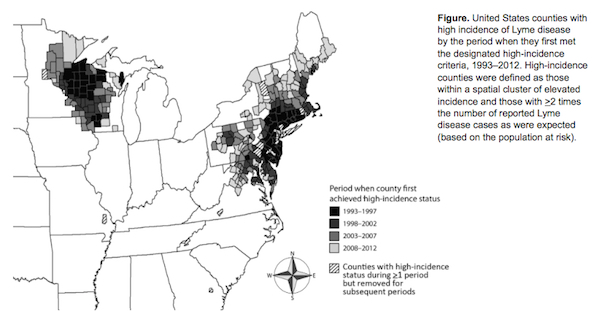Like blood tests for many other infectious diseases, the test for Lyme disease measures antibodies made by white blood cells in response to infection. It can take several weeks after infection for the body to produce sufficient antibodies to be detected. Therefore, patients tested during the first few weeks of illness will often test negative. In contrast, patients who have had Lyme disease for longer than 4-6 weeks, especially those with later stages of illness involving the brain or the joints, will almost always test positive. A patient who has been ill for months or years and has a negative test almost certainly does not have Lyme disease as the cause of their symptoms.
Because all laboratory tests can sometimes give falsely positive results, it is important when faced with a positive result to consider the underlying likelihood that a patient has the disease. If a patient has not been in an area where Lyme disease is common or their symptoms are atypical, positive results are more likely to be false positives. Similarly, if a patient is tested numerous times and only rarely tests positive, it is likely that the positive result is a false positive.
 To date, the Lyme disease maps published by the Centers for Disease Control and Prevention have pinpointed Lyme disease clusters. The CDC’s journal Emerging Infectious Diseases, made two things clear. First, where the highest risks are, and second, that the areas of highest risk are expanding.
To date, the Lyme disease maps published by the Centers for Disease Control and Prevention have pinpointed Lyme disease clusters. The CDC’s journal Emerging Infectious Diseases, made two things clear. First, where the highest risks are, and second, that the areas of highest risk are expanding.
The CDC estimates that there are 300,000 new cases of Lyme Disease each year in the United States.
Take These Steps to Protect Yourself and Your Family from Ticks
- Check any gear or clothing that you bring back from infested outdoor areas.
- Wear repellent.
- Wear light colored, long sleeved shirts and pants tucked into socks or boots.
- Talk to your doctor if you get a fever or rash.
- Place clothing in a dryer on high for an hour or more to kill ticks.
- Shower after returning from outdoor activity, then check for ticks.
- If you have a yard, clear tall grasses and bush, mow frequently etc.
- Use pesticides as necessary on lawn areas in spring and fall.
- Reduce your time outdoors when ticks are most active in warm weather.
- Check your pets and make sure they have adequate protection.
- Lastly, maintain good health and nutrition which increased chances of being able to fight infections.
Even if you’re not a nature-lover, it’s still possible to come into contact with dangerous ticks in your own backyard. Keep your yard well maintained and as unattractive to deer as possible. Deer are one of the main carriers of adult ticks, so it’s best to keep your distance from them if you can.
If you or someone you love has Lyme disease, don’t hesitate to contact Chiro-Associates. Chiropractic care can be a wonderful resource while healing from Lyme disease. Schedule a visit today, and start feeling better right away.

